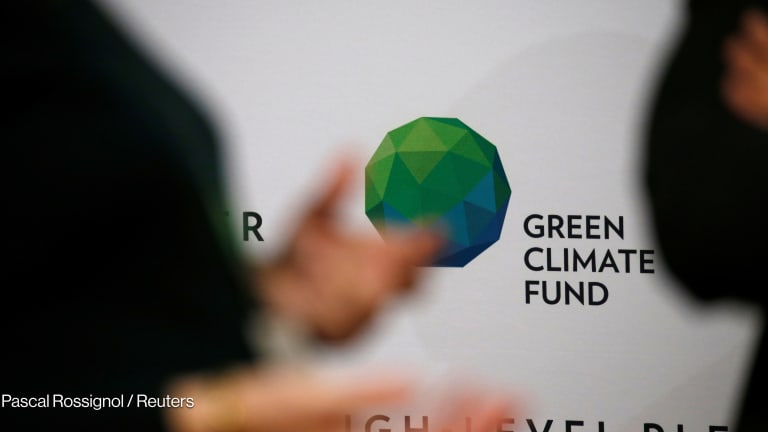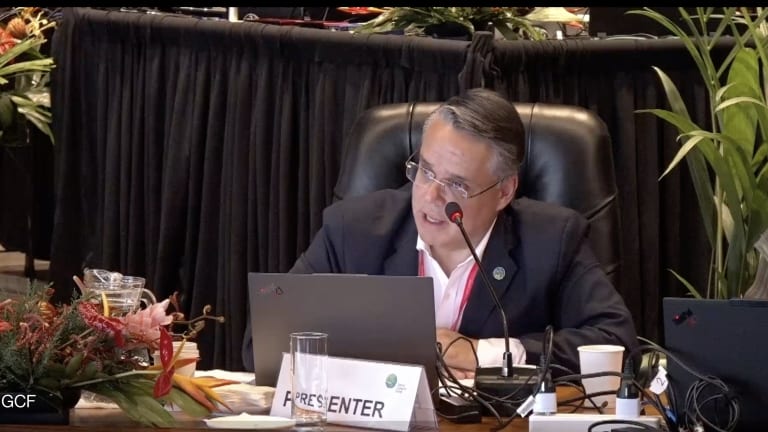UN Green Climate Fund faces replenishment challenge
The Green Climate Fund’s multibillion-dollar portfolio faces a replenishment challenge. It remains to be seen if the world’s largest international climate fund will deliver under new leader Yannick Glemarec.
MANILA — Over a month after taking the helm at the world’s largest international climate fund, Yannick Glemarec has his sights set on accelerating the implementation of the U.N. Green Climate Fund’s multibillion-dollar portfolio while navigating the highly political fund through its first replenishment process. With less than four months left to go, Glemarec and his colleagues are already busy working on aligning replenishment with the broader framework of U.N. Secretary-General António Guterres’ climate summit, which will take place in New York. United States, this September. “GCF is a unique institution with a critical role to play to scale up global climate action,” Glemarec, who was appointed executive director at the Fund’s February board meeting, told Devex. “GCF’s replenishment is crucial since this will give us the resources to help developing countries reach their climate ambitions. Our stakeholders have big expectations and ambitions for GCF-as we do.” Dwindling coffers Since the United Nations’ flagship climate fund became fully operational in 2015, it has committed $5 billion to 102 projects and programs, ranging from scaling-up clean energy access through solar-based minigrids in Mali to supporting the adoption of science-based climate information to enhance resilience in Vanuatu. But, of the donor countries’ initial pledge of $10 billion-plus to GCF, the fund only has about $2 billion left at most. That’s after factoring in the money already committed plus a total loss of about $3 billion due to currency fluctuations as well as U.S. President Donald Trump’s unwillingness to pay the remaining two-thirds of his predecessor, Barack Obama’s, $3 billion pledge. At the moment, replenishment looks to be challenging. Japan, which is GCF’s largest donor, has suggested that its second contribution will be performance based. “Japan, I think, is still smarting from its unsuccessful bid for GCF leadership [Japanese Ambassador Kenichi Suganuma didn’t even make the shortlist for executive director], but the country remains a key donor in other environmental funds, like the Global Environment Facility,” Leonardo Martinez-Diaz, global director of the Sustainable Finance Center at the World Resources Institute, tells Devex. Meanwhile, countries including Australia and the United States have made it clear that they would not contribute any more money to the U.N.’s flagship climate fund. “The Trump administration views the GCF in the same light as the Paris Agreement — as something whose basic premise it questions. Its position is therefore not surprising, but it runs counter to long-term U.S. interests,” said Martinez-Diaz, who was also a former U.S. board member at GCF. Australia, on the other hand, has a more complicated view, according to Martinez-Diaz. “Australia was an important financial contributor [to] the GCF — after first saying it would not contribute — and it very ably co-chaired the GCF board for several years,” he said. “GCF is a major funder of climate programming in the Pacific, an area of strategic interest to Australia. I wouldn’t be surprised if Australia changed its mind in the coming years.” It is important to note that replenishment is not a one-moment event, but that even after the initial pledging conference, the door will remain open to new pledges for several years, Martinez-Diaz added. “This gives the U.S. and Australia an opportunity to contribute if and when the politics change,” he noted. Wasting no time, Glemarec, a U.N. veteran, spent his first days on the job in Oslo, Norway. There, the French national joined potential contributors, board members, civil society actors, and others for the fund’s first replenishment meeting. Glemarec’s presence at the event so early in his tenure was highly welcome. “It showcases the core importance of replenishment not only for the institution but also to establish him as the executive director,” says Liane Schalatek, associate director at the Heinrich Böll Foundation North America who was present at the meeting. GCF has yet to announce a goal for how much money it wants to raise from donors this year. So far, Germany and Norway announced that they would double their last contribution to €1.5 billion ($1.8 billion) and 3.2 billion Norwegian krone ($413 million), respectively. And while these were announcements not yet formal pledges, the European countries along with other high-income countries are expected to make their commitments at the pledging conference slated for this fall after the climate summit, likely in October or November. GCF and the U.N. climate summit GCF has a broad mandate to support low- and middle-income countries in realizing their climate ambitions. But, in preparation for the climate summit, GCF is trying to demonstrate how exactly the fund can provide added value to the various strands that will be explored at the event and thus help support global ambitions. The six areas of focus range from a global transition to renewable energy to sustainable and resilient infrastructures and cities. “For us, it’s politically important that we use this opportunity to put GCF replenishment on the map, but it’s also significant in terms of climate that we identify what our niche is compared with the actions of others,” Simon Wilson, head of communications at GCF, told Devex. The low-hanging fruit is undeniably climate finance. GCF was created to channel finance to LMICs and support them in achieving their country pledges to reduce emissions as part of the Paris Agreement on climate change’s overall goal to keep global warming well below 2 degrees Celsius. But, what is less obvious is the specific role the fund will play within the climate finance space. It is arguably a crowded one that also includes the Kyoto Protocol’s Adaptation Fund, the European Union’s Global Climate Change Alliance Plus and the longest-running international environmental fund, the Global Environment Facility, among others. “While there’s a lot of climate finance out there, there are not many organizations that have got the risk profile that we have,” Wilson said. “So what is our niche role? Is it to open up new markets to allow bigger and better investments to come in or is it about focusing in particular areas like least developed countries or small island developing states, for example?” Accelerating implementation of funds While GCF is trying to figure that out, Glemarec says that he also wants to focus his efforts on accelerating the implementation of GCF’s portfolio and building a pipeline of transformative projects. “Both of these will require close collaboration with developing countries as well as strengthening relations with our project partners,” he said. Currently, only $2.18 billion or about 44% of the $5 billion that GCF has committed has been disbursed. While this is a vast improvement from about a year and a half ago when the fund released only about $150 million or less than 6% of what it had committed up to that point, there’s still a lot of room for improvement. As Devex previously reported, what is causing the delay has mostly to do with the legal documentation requirements and various conditions that are imposed on projects when they get approved. For instance, two documents, the accreditation master agreement and the funded activity agreement, need to be signed before any money is disbursed. But, some of the accredited entities putting forward project proposals have been taking an extremely long time to come to a negotiated agreement with GCF on the necessary paperwork guiding their relationship. For instance, it took the World Bank more than a year to sign their accreditation master agreement. Meanwhile, some civil society groups hope that in building a pipeline of transformative projects, Glemarec will draw from his experience as a former deputy executive director for UN Women and work with them to promote the importance of a gender-responsive approach to climate investments. “We challenge him a little bit to continue to provide more opportunities for stakeholder engagement and increase transparency at the fund,” said Heinrich Böll’s Schalatek, who is an active observer for civil society groups at GCF. More updates are expected at GCF’s next board meeting in July, which will mark Glemarec’s first board meeting as executive director and the last one that will be held before September's U.N. climate summit.
MANILA — Over a month after taking the helm at the world’s largest international climate fund, Yannick Glemarec has his sights set on accelerating the implementation of the U.N. Green Climate Fund’s multibillion-dollar portfolio while navigating the highly political fund through its first replenishment process.
With less than four months left to go, Glemarec and his colleagues are already busy working on aligning replenishment with the broader framework of U.N. Secretary-General António Guterres’ climate summit, which will take place in New York. United States, this September.
“GCF is a unique institution with a critical role to play to scale up global climate action,” Glemarec, who was appointed executive director at the Fund’s February board meeting, told Devex.
This story is forDevex Promembers
Unlock this story now with a 15-day free trial of Devex Pro.
With a Devex Pro subscription you'll get access to deeper analysis and exclusive insights from our reporters and analysts.
Start my free trialRequest a group subscription Printing articles to share with others is a breach of our terms and conditions and copyright policy. Please use the sharing options on the left side of the article. Devex Pro members may share up to 10 articles per month using the Pro share tool ( ).
Fatima Arkin is a Devex contributor specializing in climate change, human rights, and sustainable development. She has reported across Asia, Africa, Europe, and North America for Foreign Policy, SciDev.net, Maclean's, and many others. She holds a B.A. in international development and history from McGill University and a graduate diploma in journalism from Concordia University, both located in Montreal, Canada.








